with both eyes wide open:

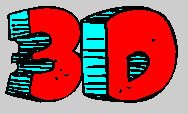
Not sissy stuff like DOOM!
real anaglyph stereo viewing
See what I mean?
This only works when you've got two working eyes, sorry:
Close one of them. Bring your left hand to eye height and point your index finger to the right at reading distance.
Release your mouse and put your other finger opposite the first one. Now try to make your fingers touch.
See? you can't do it - but with 2 eyes open it's easy!
Now that's anaglyph stereo.
On a normal screen or photo, you see the same with both eyes - "flat".
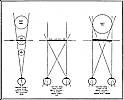
how the trick works
The first Stereo Color Film in Sound was made in Germany in 1937, according to Zeiss.
Around 1950, there was a great interest in 3D. Hollywood producers saw television as competition, not realizing that it was a new market for them. Many different systems appeared, but in a couple of years it was all over and done with - nobody really knows why, but mostly, inferior program material has been blamed. 3D became box office poison. At last, a more prestigious movie like Alfred Hitchcock's 3D Dial M for Murder had to be released "flat".
It Was Done with Mirrors




Several set-ups were in use, all designed to deliver two viewpoints to simulate "Natural Vision" (one of the trade marks).
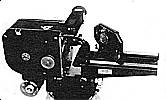
One of the smallest set-ups was the Dutch "Verivision" system.
It used one camera to expose two Techniscope-like letterbox frames on one academy frame
(but the bulky film magazine is not shown here).
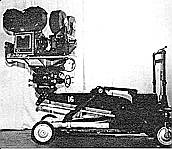
The no doubt most impressive rig comprised two Technicolor 3-strip cameras - a veritable monster.
Only two productions have been shot with it.
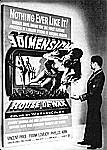
lobby display for Warner Brothers'
House of Wax



now a popular cult film
Since I uploaded this page, digital production has made its entrance into studios and cinemas, and with it, a veritable wave of 3D films. There are programs and even programmable projectors that will turn your "flat" movies into 3D, with variable results. But the principle remains the same as described here for old-fashioned 35mm film.
It Was Seen with Glasses
Essentially, the two images were projected over each other through different color or polarizing filters. The audience was equipped with either polarizing glasses (the origin of the Polaroid sunglasses, maybe), or red-green or red-blue ones, so each eye picked up the correct image. A full house with those glasses on made for a weird sight, but who was looking at them? - I still don't think the 20th Century Fox slogan for CinemaScope "You See It Without Glasses!" was that good. Cinematographer Leon B. Shamroy for the first 20th Century Fox widescreen production "The Robe — in CinemaScope" flatly stated it had no 3D effect. But Fox released some what you have to call pretty good films for starters, and the rest is history.
3D was an incredible headache, both in production and in the cinema. When one of the two film strips broke, you had to make a splice in the other one at the same place as well, or the public would go home with a headache of it's own.
The 2008 revival based on digital projection technology may hold out longer as it lacks all those problems; the techniques are essentially the same. However, digital projectors are still incredibly expensive and restricted to top-notch first-run theaters. The future may be in digital video screens, a technique now in development. Then again, it may all be a passing fad, again - what's the use of watching a 3D movie on a 2" mobile phone screen?
Tell you the honest truth, for most purposes it's just too distracting - like Duke Ellington calls for too much attention to be satisfactory movie music.
I have always felt 3D was worth it, anyway. I have made a lot of stereo still pictures, and have stereo glasses to play computer games with.
The Curaçao island simulations I am working on really need anaglyph 3D, which cannot be done - yet.
The same goes for the "3D" simulations I have been building with
Internet Space Builder

| 3D revival At the Egyptian Theatre, Hollywood, there has been a revival of 3D movies September 2003. The program contained classics like Dial M for Murder, Bwana Devil, Creature from the Black Lagoon and House of Wax. Many more surprising titles!. |
Now It Can Be Done!
In the 1980s, a Paris theater got it all together and showed, some 25 years after its original release, Alfred Hitchcok's Dial M for Murder in 3-D. It ran for over a year. I had the incredible luck of being around to see it - it was great. I remembered the movie having a grainy, washed-out appearance. In 3D it's razor-sharp with rich blacks.

some of my own efforts in 3D photography
There used to be a VHS tape around Roller Coaster Thrills - in 3D. The process works something like this: NTSC writes one half of those horizontal TV lines first, then the other half ("interlacing"). When you darken the Left image for the first half, and lighten Right for the next scan, plus wear dark-light glasses your anaglyph vision is there. Works fine.
On my ASUS video-card plus glasses, the effect is even better. It's what IMAX used in a show you had to watch with special (and very expensive-looking) glasses, about 1900 New York. It was embarrassingly bad, also because they had used old stereo photos in the movie; those old guys turned out to have had a much better feeling for 3-D than the IMAX movie makers.
Well, as long as those guys in Hollywood are getting it all together anyway
"Why not release Dial M for Murder (and then some) in 3D and give the population two eye-fulls?"
Please?

more on
Screen Aspect Ratios


| Search this site powered by FreeFind |


Custom Search
copyright notice
all material on this site, except where noted
copyright © by harrie verstappen , curaçao
reproduction in any form for any purpose is prohibited
without prior consent in writing